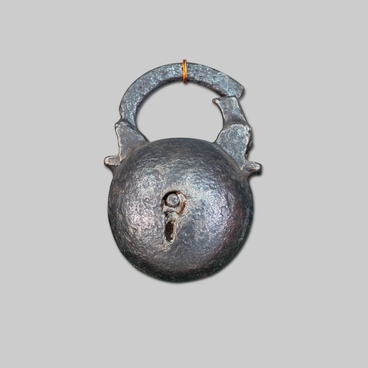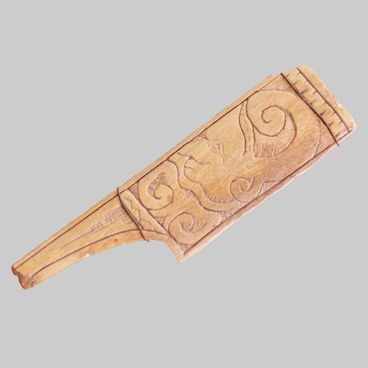Bone carving was very popular in Kuznetsk, but the purpose was merely practical. Well-crafted, highly decorated items were mainly imported. The museum collection contains a sample carved onlay. The convex face side of the onlay is adorned with a floral ornament, the item is polished.
One of the principal bone carving centers in Russia was Pomorye. Carvers from Kholmogory possessed various techniques: engraving, open-work bone-carving, high- and low-relief carving, thy could dye bones brown or green. They used various saws, rasps, drills, chisels, piercers that allowed making very fine slots in the bone, creating very small-scale prominent compositions of detailed design.
Clear artistic orientation of bone processing in Kholmogory region has various reasons behind it. By XVII century, rich traditions of the northern Russian art had developed in the Northern Dvina region. People built wooden and stone houses and churches, there were many wood carvers, icon painters and decorative painters, blacksmiths, potters and jewelers. Book writers decorated the book pages of manuscripts with finely colored miniatures and grass ornaments. In end XVII — early XVIII centuries Kholmogory became one of the largest cultural centers where significant artistic forces were concentrated. Bone carving was developing alongside and in connection with all other local arts and crafts.
One of bone-carving craft centers in Siberia was the city of Tobolsk. Traditionally, bone carving has been popular with the indigenous population of the North – Khanty, Mansi, Nenets people. Large amounts of mammoth bones found in Priobye (along the Ob river banks) also contributed to the development and success of bone carving arts. Tobolsk carved bones were first mentioned early in XVIII century. In those times craftsmen manufactured combs, tobacco boxes, powder-flasks, jewelry boxes, bone ornaments for weapons, buttons, etc. It was also in those times that Tobolsk craftsmen started making the first sculptures.
A unique traditional type of bone processing – an inlay – was also spread in Tobolsk. Jewelry boxes, chess boxes made of white bone were decorated with design of bones of various natural colors.
One of the principal bone carving centers in Russia was Pomorye. Carvers from Kholmogory possessed various techniques: engraving, open-work bone-carving, high- and low-relief carving, thy could dye bones brown or green. They used various saws, rasps, drills, chisels, piercers that allowed making very fine slots in the bone, creating very small-scale prominent compositions of detailed design.
Clear artistic orientation of bone processing in Kholmogory region has various reasons behind it. By XVII century, rich traditions of the northern Russian art had developed in the Northern Dvina region. People built wooden and stone houses and churches, there were many wood carvers, icon painters and decorative painters, blacksmiths, potters and jewelers. Book writers decorated the book pages of manuscripts with finely colored miniatures and grass ornaments. In end XVII — early XVIII centuries Kholmogory became one of the largest cultural centers where significant artistic forces were concentrated. Bone carving was developing alongside and in connection with all other local arts and crafts.
One of bone-carving craft centers in Siberia was the city of Tobolsk. Traditionally, bone carving has been popular with the indigenous population of the North – Khanty, Mansi, Nenets people. Large amounts of mammoth bones found in Priobye (along the Ob river banks) also contributed to the development and success of bone carving arts. Tobolsk carved bones were first mentioned early in XVIII century. In those times craftsmen manufactured combs, tobacco boxes, powder-flasks, jewelry boxes, bone ornaments for weapons, buttons, etc. It was also in those times that Tobolsk craftsmen started making the first sculptures.
A unique traditional type of bone processing – an inlay – was also spread in Tobolsk. Jewelry boxes, chess boxes made of white bone were decorated with design of bones of various natural colors.



